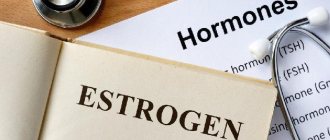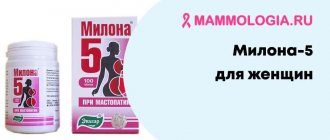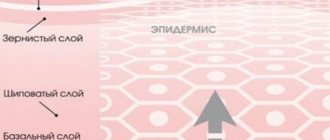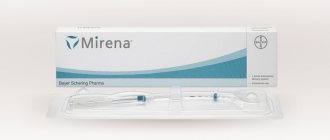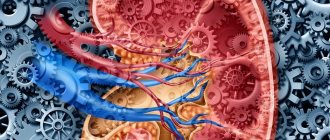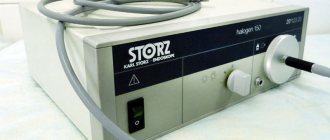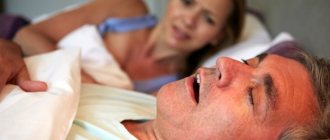Complexes with this research
Advanced anti-aging diagnostics in postmenopause Advanced monitoring of age-related changes during postmenopause 29,710 ₽ Composition
Check-up No. 1 for children and adolescents Annual preventive examination program 11,130 ₽ Composition
Women's anti-aging diagnostics Monitoring of basic blood parameters in women aged 40+ 12,280 ₽ Composition
IN OTHER COMPLEXES
- Anti-aging diagnostics. Hormonal balance RUB 6,350
- Male hormones RUB 6,290
- Female hormones. Luteal phase RUB 1,190
- Advanced women's anti-aging diagnostics RUB 29,130
- Anti-aging diagnostics in postmenopause RUB 12,860
Estradiol dipropionate
Orally, without chewing, with a small amount of liquid, 2 mg/day, for 21 days, followed by a break for 7 days, after which treatment is continued. The duration of treatment is up to 6 months, after which an examination is carried out to decide whether it is advisable to continue estrogen replacement therapy. In women with a uterus removed or in menopausal women, treatment can begin on any day. If the menstrual cycle is preserved, the first tablet should be taken on the 5th day of the cycle (1st day of the cycle = 1st day of menstruation).
IM, in the form of a 0.1% solution of estradiol dipropionate in oil: for primary amenorrhea with underdevelopment of the genital organs and secondary sexual characteristics - 1-2 mg daily or every other day for 1-2 months or more, until palpable enlargement of the uterus; after this - progesterone intramuscularly, 5 mg daily for 6-8 days. If necessary, repeat courses of hormone therapy are carried out. For secondary amenorrhea - 1 mg daily for 15-16 days, followed by progesterone or pregnin for 6-8 days. If there is no persistent clinical effect, the course of treatment is repeated. For hypo- and oligomenorrhea, dysmenorrhea, infertility due to ovarian hypofunction and underdevelopment of the uterus - 0.5-1 mg for 15-16 days after the end of menstruation and then, if indicated, progesterone or pregnin for 6-8 days. The course of treatment can be repeated several times at the same time, after the end of menstruation. For pathological phenomena associated with the onset of menopause and surgical removal of the ovaries - 0.5-1 mg daily or every 1-2 days, in courses of 10-15 injections. If symptoms return, the course of treatment is repeated. Doses should be selected strictly individually depending on the phase of menopause and the severity of the disease. In case of weakness of labor and post-term pregnancy - intramuscularly, 4-5 mg 2-3 hours before the introduction of birth-stimulating drugs. As a hemostimulating drug, when the number of leukocytes decreases below 2 thousand/μl of blood (usually from 10-20 days after irradiation for severe lesions and from 15-18 days for milder lesions) - 1 mg every 1-2 days. The course of treatment is 10 injections (if necessary - up to 15 injections).
TTS is attached to a clean, dry and intact area of body skin (lumbar region, abdomen) 2 times a week. Treatment begins with TTC 50 mcg, followed by individual dose selection (the appearance of a feeling of tension in the mammary gland or intermediate bleeding is a sign of an increased dosage that needs to be reduced). If after 2-3 weeks the signs and symptoms of estrogen deficiency do not stop, the dose should be increased. TTC is applied cyclically: after 3 weeks of treatment (6 applications) - an interval of 7 days, during which metrorrhagia is possible. Continuous, non-cyclic therapy is indicated for women following a hysterectomy or in cases where symptoms of estrogen deficiency become severe again during the 7-day interval. Subsequent therapy with gestagens should be carried out according to the following scheme: with continuous use of TTC, it is recommended to additionally prescribe a gestagen (10 mg medroxyprogesterone acetate, 5 mg norethisterone, 5 mg norethisterone acetate or 20 mg dydrogesterone in the first 10-12 days of each month). When using TTC cyclically, it is recommended that in the last 10-12 days of estradiol therapy, additional gestagen be taken so that the fourth week of each cycle remains free from therapy with any hormone. In both cases, after the end of 10-12 days of gestagen therapy, bleeding occurs.
The gel is used once a day, in the morning or evening, 1.5 mg (2.5 g of gel or 1-2 doses) - applied in a thin layer to clean skin of the abdomen, lumbar region, shoulders and forearms. The application area should be equal in size to 1-2 palms. The gel should be absorbed in less than 2-3 minutes. If it remains on the surface of the skin for more than 5 minutes, then the drug was applied to too small a surface of the skin. The gel is prescribed continuously or in cycles. Doses and duration of therapy are determined individually.
When should you take an Estradiol test?
- Suspicion of infertility;
- In assisted reproductive technologies;
- Menstrual irregularities;
- Prostate cancer;
- Diagnosis of estrogen-producing tumors;
- Hypogonadism (impaired normal functioning of the testicles, leading to a decrease in the production of sex hormones) in males;
- Evaluation of low-dose replacement therapy with drugs containing estradiol;
- Evaluation of anti-estrogenic therapy (therapy with aromatosis inhibitors in men with prostatic hyperplasia).
MEDICAL CENTER
The most active estrogenic (female) sex steroid hormone.
In women, it is produced in the ovaries, in the placenta and in the zona reticularis of the adrenal cortex under the influence of follicle-stimulating hormone (FSH), luteinizing hormone () and prolactin. Estradiol is formed in small quantities during the peripheral conversion of testosterone. In men, estradiol is formed in the testes, in the adrenal cortex, but most of it is formed in peripheral tissues due to the conversion of testosterone.
In women, estradiol ensures the formation of the reproductive system according to the female type, the development of female secondary sexual characteristics during puberty, the formation and regulation of menstrual function, the development of the egg, the growth and development of the uterus during pregnancy; is responsible for the psychophysiological characteristics of sexual behavior. Ensures the formation of subcutaneous fat tissue according to the female type. By reducing the resistance of the uterine vessels, it increases blood flow in it and stimulates endometrial hyperplasia. Ovulation occurs 24 to 36 hours after the occurrence of above-threshold estradiol levels. A necessary condition for the effects of estradiol to occur is the correct relationship with testosterone levels. Estradiol has an anabolic effect, enhances bone turnover and accelerates the maturation of skeletal bones. Promotes sodium and water retention in the body. Reduces cholesterol levels and increases blood clotting activity. Estradiol affects the release of neurotransmitters, contributing to increased nervous tension and irritability.
Daily fluctuations in the concentration of estradiol in the serum are associated with the rhythm of LH (luteinizing hormone) secretion: the maximum occurs from 15 to 18 hours, and the minimum between 24 and 2 hours. In men, the level of estradiol progressively increases, in boys the increase occurs to a lesser extent.
In women of childbearing age, the level of estradiol in blood serum and plasma depends on the phase of the menstrual cycle. At the beginning of the cycle, the concentration of estradiol slowly increases. The highest levels of estradiol are observed in the late follicular phase. After ovulation, the hormone level decreases, and a second, smaller amplitude, rise occurs. Then there is a decline in the concentration of the hormone, which continues until the end of the luteal phase. During pregnancy, the concentration of estradiol in serum and plasma increases at the time of delivery, and after delivery it returns to normal on the 4th day. With age, women experience a decrease in estradiol concentrations. During postmenopause, the concentration of estradiol decreases to the level observed in men. Limits of detection: 37.0 pmol/l -40370 pmol/l
Detailed description of the study
Estradiol is a steroid hormone that is synthesized from androgens. It is actively produced in ovarian cells during a woman's reproductive life. Estradiol is necessary for the normal development and functioning of the female genital organs and secondary sexual characteristics (enlarged mammary glands, female-type hair growth, etc.), maintaining the normal functioning of the reproductive system. In men, estradiol is also present in the body; it is formed in small quantities in the testicles and adrenal glands.
This steroid hormone plays a central role in female sexual development. Estradiol acts by binding to specific receptors in the tissues of the uterus, appendages, mammary glands, and external genitalia. It has indirect effects on the skin, blood vessels, bones, muscles, liver cells, adipose tissue, kidneys, gastrointestinal tract, brain, lungs and pancreas. A decrease in its concentration in plasma contributes to the development of coronary heart disease, stroke and breast cancer.
Estradiol levels, together with measurements of follicle-stimulating hormone (FSH) and luteinizing hormone (LH), determine the stage of the menstrual cycle. The first phase of the menstrual cycle is associated with an increase in estradiol, so its determination is important for diagnosing menstrual irregularities.
It plays an important role in controlling food intake and energy balance. This is supported by the fact that the incidence of obesity increases significantly after menopause, when the synthesis of this hormone decreases. A decrease in estradiol levels is one of the reasons for the development of postmenopausal osteoporosis.
Estradiol in therapeutic doses is used for conditions and diseases that result in a decrease in the level of endogenous estradiol. This hormone is also included in oral contraceptives and hormone replacement therapy for severe menopause.
Estradiol levels change during the development of breast cancer. An assessment of this hormone in postmenopausal women is needed to determine the likelihood of developing breast cancer, especially if there are close relatives with this disease.
Women planning IVF (in vitro fertilization), as well as undergoing drug stimulation of ovulation, need estradiol determination. This is necessary to establish the timing of human chorionic gonadotropin administration to trigger ovulation and assess thresholds associated with the risk of overstimulation.
Estradiol production increases in men with the development of prostate cancer. In men suffering from gynecomastia - enlarged mammary glands - estradiol is also increased.
A blood test for estradiol can identify disturbances in the production of this hormone in various diseases and conditions in men and women.
Estradiol (Oestradiolum)
Before starting use, it is necessary to conduct a complete general medical and gynecological examination, including examination of the abdominal and pelvic organs, mammary glands, blood pressure measurement, and cytological analysis of the endometrium. Pregnancy must be excluded. During long-term therapy, such examinations should be carried out every 6-12 months.
4-6 weeks before planned surgery and during a period of prolonged immobilization, it is recommended to interrupt treatment to avoid thrombosis.
The drug should be stopped immediately in the following cases: deep vein thrombosis, thromboembolic diseases, significant increase in blood pressure, the appearance of jaundice, the appearance of migraine-like headache, sudden visual impairment.
During hormone replacement therapy in patients with hypertension, blood pressure should be regularly monitored.
Changes in estrogen levels in the blood may affect some endocrine and liver function tests.
Estrogens can cause fluid retention in the body, so patients with impaired cardiac or renal function require careful monitoring.
It is necessary to inform your doctor about the simultaneous use of barbiturates, phenylbutazone, hydantoins, rifampicin, the appearance of irregular bleeding or unusually heavy bleeding in the period between the use of the drug, discomfort in the epigastric region.
If irregular uterine bleeding occurs while taking the drug, a cytological analysis of the endometrium should be performed.
During treatment, it should be taken into account that long-term use of estrogen alone during menopause can lead to endometrial hyperplasia and increases the risk of developing endometrial cancer. To reduce the risk of developing endometrial cancer, additional intake of progestogen is necessary (usually for 10-12 days a month), which leads to the transition of the uterine mucosa into the secretory phase with its rejection and subsequent menstrual-like bleeding after stopping the administration of progestogen. If irregular menstrual flow appears (in women with an intact uterus) during treatment with estradiol, a diagnostic curettage is necessary to exclude a malignant neoplasm of the uterus.
Postmenopausal women on long-term hormone replacement therapy have an increased risk of breast cancer. When treatment lasts more than 5 years, the positive effects of treatment must be carefully weighed against the adverse effects.
In patients undergoing long-term treatment, regular examination of the mammary glands is necessary, including training them in regular self-examination. Particular caution should be exercised when prescribing estrogens to women who have or have had in the past nodular or fibrocystic changes in the mammary glands. In such cases, careful monitoring and regular mammography are necessary.
Women taking estrogen drugs during menopause have an increased risk of cholelithiasis (estrogens increase the lithogenicity of bile).
The drug is not a contraceptive and does not restore the ability to fertilize.
The patch should not be placed on the breast or waist area. If the patch is applied correctly, you can take a bath or shower, but keep in mind that the patch may come off in hot water.
Transdermal systems with estradiol are prescribed only to women.
Avoid contact of the gel with the mammary glands and mucous membranes of the vulva and vagina.
References
- Lønning, P. Estradiol measurement in translational studies of breast cancer. Steroids, 2015. - Vol. 99(Pt A). — P. 26-31.
- Butera, P. Estradiol and the control of food intake. PhysiolBehav., 2010. —Vol. 99(2). - P. 175-80.
- Vesper, H., Botelho, J., Wang, Y. Challenges and improvements in testosterone and estradiol testing. Asian J Androl., 2014. - Vol. 16(2). — P. 178-84.
- Rosner, W., Hankinson, S., Sluss, P. et al. Challenges to the measurement of estradiol: an endocrine society position statement. J Clin Endocrinol Metab., 2013. - Vol. 98(4). - P. 1376-87.
Estradiol (E2)
What is estradiol (E2, Estradiol)?
It is the most active estrogenic (female) sex steroid hormone. From a biosynthetic point of view, estradiol is a derivative of cholesterol, and its immediate precursors are androstenedione and testosterone. In women, it is produced in the ovaries, placenta and adrenal cortex under the influence of follicle-stimulating hormone (FLH), luteinizing hormone (LH) and prolactin. Estradiol is formed in small quantities during the conversion of testosterone. Estradiol ensures the formation of the reproductive system according to the female type, the development of female secondary sexual characteristics in adolescence, the regulation of the menstrual cycle, the development of the egg, the growth and development of the uterus during pregnancy, is responsible for the psychophysiological characteristics of sexual behavior, and ensures the formation of subcutaneous fatty tissue according to the female type. The main effect is to cause increased growth of cells lining the uterus from the inside, which prepares it for pregnancy and, by reducing the resistance of the uterine vessels, increases blood flow in it. In women of childbearing age, the level of estradiol in serum and blood plasma depends on the phase of the menstrual cycle. At the beginning of the cycle, the concentration of estradiol slowly increases. The highest levels of estradiol are observed at the end of the follicular phase - before ovulation. Ovulation (rupture of the follicle and release of the egg) occurs 24-36 hours after the concentration of estradiol reaches its maximum level. After ovulation, hormone levels begin to decline, but during the luteal phase they rise again. If conception does not occur, estradiol levels drop to a minimum, which determines the onset of menstruation. If conception has occurred, the concentration of estradiol continues to increase. During pregnancy, the concentration of estradiol in the blood increases at the time of birth, and after birth it returns to normal on the 4th day. With age, women experience a decrease in estradiol concentrations. During postmenopause, the concentration of estradiol decreases to very low values. Since normally in women most of the estradiol is synthesized in the ovaries, analysis of its concentration can be considered a way to assess ovarian function. In addition, determination of estradiol levels is used as part of examination for amenorrhea, premature sexual development, infertility in men and women, to assess the onset of menopause. Monitoring the concentration of estradiol is necessary in preparation for in vitro fertilization, since oocyte retrieval is carried out at a certain phase of follicle development, which depends on the concentration of estradiol.
In men, estradiol is formed in the testes, in the adrenal cortex, but most of it is formed in peripheral tissues due to the conversion of testosterone.
Estradiol has an anabolic effect, enhances bone turnover and accelerates bone growth in length. Promotes sodium and water retention in the body. Reduces cholesterol levels and increases blood clotting activity. Estradiol increases nervous tension and irritability.
Daily fluctuations in the concentration of estradiol in the blood serum are associated with the rhythm of luteinizing hormone (LH) secretion: the maximum occurs between 15 and 18 hours, and the minimum between 24 and 2 hours.
Indications for the purpose of analysis:
- pituitary insufficiency;
- amenorrhea and oligomenorrhea;
- anovulation;
- hypogonadism;
- puberty disorder;
- dysfunctional uterine bleeding;
- osteoporosis in women;
- hirsutism;
- infertility;
- premenstrual syndrome;
- bacterial vaginosis;
- assessment of the functioning of the fetoplacental complex in early pregnancy;
- signs of feminization in men;
- monitoring during in vitro fertilization (IVF);
- polycystic ovary syndrome;
- menopausal metrorrhagia;
- tumors of the ovaries and adrenal glands;
- azoospermia and oligospermia.
When are estradiol levels elevated?
- Persistence of the follicle (hyperestrogenism).
- Endometrioid ovarian cysts.
- Hormone-secreting ovarian tumor.
- Estrogen-secreting testicular tumor.
- Cirrhosis of the liver.
- Taking medications (anabolic steroids, carbamazepine, cimetidine - in men and postmenopausal women, clomiphene - in postmenopausal women, ketoconazole - in hyperandrogenic women, mifepristone - in patients with meningiomas, nafarelin - with subcutaneous administration for polycystic ovary syndrome, phenytoin , tamoxifen, troleandomycin, valproic acid; estrogens - oral contraceptives).
When are estradiol levels low?
- Intense physical activity in untrained women.
- Significant weight loss.
- A high carbohydrate, low fat diet for vegetarians.
- Tobacco smoking.
- Pregnancy in the early stages.
- Shershevsky-Turner syndrome.
- Testicular feminization.
- Hypogonadism.
- Hyperprolactinemia.
- Pituitary dwarfism.
- Luteal phase deficiency.
- Virile syndrome.
- Chronic inflammation of the internal genital organs.
- Threat of miscarriage of endocrine origin.
- Chronic prostatitis.
- Taking medications (aminoglutethimide, buserelin, chemotherapy drugs, cimetidine, cyproterone, danazol, dexamethasone, epostane, megestrol, mifepristone - for miscarriage, moclobemide, nafarelin, nandrolone, octreotide, oral contraceptives, pravastatin).

